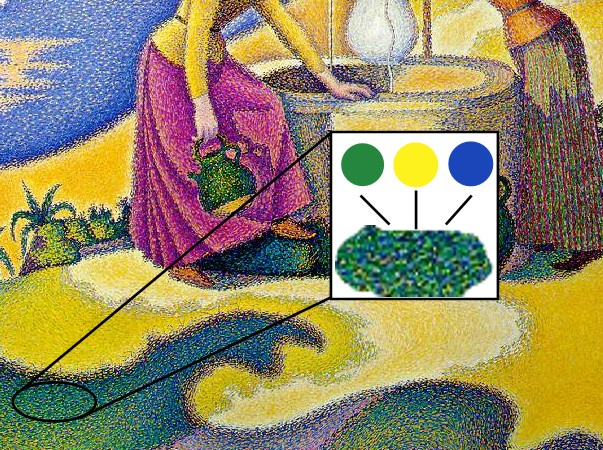 |
| "Women at the Well" by Paul Signac (1863-1935) |
In Josef Albers' Interaction of Color, Albers covered a lot of concepts on color theory that I could barely comprehend as it changed my perspective on how we view colors as he explained them so frankly in my brief skim through the chapters. There were chapters on optical illusions, and chapter XIII on The Bezold Effect (page 33) briefly covered optical mixtures, which is exactly what pointillism is about. The combinations of the colors colors green, yellow, blue, and magenta are prominently used in "Women at the Well" to create hues and shades that provide contrast and make the subjects and background realistic and 3-dimensional.The limited color palette make it a challenge and forces the painter to create optical illusions of color.
Yellow and white are the main colors that provide light in the image. The cool blue creates a stark contrast to the yellow because they are complementary colors, so their synthesis in the painting make it more vibrant and bright. Their juxtaposition in the painting creates a balance of yin and yang; if you look closely on bottom of the lower half of the painting, the shape of what seems to be a shadow exhibit a kind of balance and so does the top half where the two colors are separated diagonally by the shape of the hill.
Color transforms everything in the visual world. Albers mentions in his book that the visual perception of color is subjective because it is "almost never seen as it really is," and there are innumerable meanings and perceptions of every single color. "Women at the Well" displays this idea effectively because the hues and shades in the painting are achieved through the brain's perception of the color combinations, whether they subtract or add intensity, and it harmonizes them in allows the viewer visualize the whole painting and its hues and shades instead of each the actual individual colors.
Color transforms everything in the visual world. Albers mentions in his book that the visual perception of color is subjective because it is "almost never seen as it really is," and there are innumerable meanings and perceptions of every single color. "Women at the Well" displays this idea effectively because the hues and shades in the painting are achieved through the brain's perception of the color combinations, whether they subtract or add intensity, and it harmonizes them in allows the viewer visualize the whole painting and its hues and shades instead of each the actual individual colors.
Credit / Links:
["Women at the Well" photo of painting] http://www.terminartors.com/artworkprofile/Signac_Paul-Women_at_the_Well
[Close up, detail of "Women at the Well"] http://en.wikipedia.org/wiki/Pointillism
[Paul Signac bio] http://www.paul-signac.com/
[Josef Albers' Interaction of Color] http://www.amazon.com/Interaction-Color-Revised-Josef-Albers/dp/0300018460
[Paul Signac bio] http://www.paul-signac.com/
[Josef Albers' Interaction of Color] http://www.amazon.com/Interaction-Color-Revised-Josef-Albers/dp/0300018460

No comments:
Post a Comment